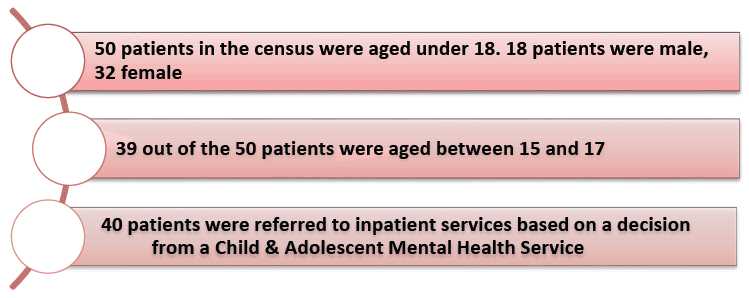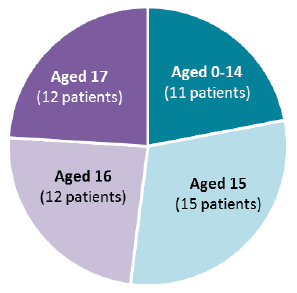Mental Health & Learning Disability Inpatient Bed Census, 2014
Overview of the results of the first Mental Health & Learning Disability Inpatient Bed Census, carried out by the Scottish Government and NHS Boards as at midnight, 29 October 2014. The report provides evidence for Commitment 26 of the Mental Health Strategy for 2012 to 2015, but also enhances the Scottish Government’s and NHS Scotland’s understanding of mental health, addiction and learning disability services, and about the patients who use these services.
This document is part of a collection
1(c). Children and young people (all patients aged under 18)

This section of the report looks at patients in the census aged under 18, regardless of whether they receive a Child & Adolescent Mental Health Service (CAMHS). The total patient population is smaller than that described in other sections of the report, so information on young patients is presented at a high level only.
- There were 50 mental health, addiction or learning disability inpatients aged under 18 in the October census.
- These patients are mostly aged 15 to 17 (39 out of 50 patients).
- These patients were mostly treated in Regional Services located in NHS Greater Glasgow & Clyde, NHS Lothian and NHS Tayside.
- Four additional NHS Boards returned data on a very small number of patients aged under 18, while six boards (excluding NHS Orkney and NHS Shetland) did not return any data on under 18s.
Young patients: age breakdown

- Of the 50 patients aged under 18 at the census, 18 were male and 32 were female. This is a reversal of the trend for working age adults (65% male).
- 38 out of the 50 patients were in a Children or Young People's Unit. There were 10 patients aged 16 or 17 who were recorded as being in the same ward as patients aged 18 or over.
- 38 out of the 50 patients were seen by a consultant who specialized in Child and Adolescent Psychiatry (other specialties include General Psychiatry and Learning Disability).
- 40 out of the 50 patients were referred from a Child & Adolescent Mental Health Service (CAMHS) (Others include Community Mental Health Service and Crisis Service).
- At the time of admission, 22 patients had a "formal" status, meaning they were being detained under the Mental Health Act 2003. 28 patients had an "informal" status. As at the census date, 24 patients had a "formal" status, and 26 patients had an "informal" status.
- The average (median) number of days since admission at the time of the census for young people was 63 days (2 months & 3 days).
Contact
Email: David Scott / Ellen Lynch
There is a problem
Thanks for your feedback